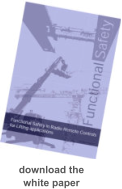autec safety remote controls
What is a safety remote control?
Safety remote controls are specially designed for the control of potentially hazardous machinery - for example cranes and hoists, concrete pumps, container side-lifters, elevating work platforms, and many others. Safety remote controls are necessary where the failure of the system (e.g. a command turning on unexpectedly, or the STOP failing to operate) could pose a risk of injury or death, or of damage to the machine or other property. Safety remote controls include many special features that increase Functional Safety by increasing the fault-tolerance of the systems. Safety remote controls share little in common with general-purpose remote controls (such as door openers) which do not fail-to-safety. Different applications require different levels of Functional Safety, and various Standards define different categories and performance levels that are sometimes mandated for specific machine types. Safety remote controls must contain specific design features to meet these strict requirements. Amongst these are: - Dual redundant input devices (e.g. joysticks) - Dual redundant output devices (e.g. relays) - Redundant and self-monitoring encoders and decoders - Tamper proof and guaranteed unique addressing systems - Active and passive STOP systems - High-reliability radio links with frequency management These issues are fully discussed in our white paper on Functional Safety in remote control systems, which is recommended reading for anyone considering the application of radio remote controls to machines.Types of safety radio remote control
When selecting a radio remote control for a machine, the best approach is to consider the application firstly from the operator’s perspective: - What form-factor is appropriate? A hand-held controller, or a “belly-box” (a controller worn around the waist)? - What actuators suit the commands that must be given? The available choices, depending on the model of controller, include - single-speed push-buttons - 2-speed push-buttons - Single-speed joysticks (on-off types) - Multi speed joysticks (up to 5 or 6 steps)- typically used on cranes - Fully proportional joysticks- typically used on hydraulic machinery, but also on variable-speed drives - Toggle switches in latching/momentary types - Potentiometers (so-called “pots”) typically used to allow a knob to control the speed of an operation. The design of the machine will also influence the choice of controller, and of the receiver. Considerations include the power supply available, the load being switched, the available space for the installation, and the types of control devices (contactors, valves, solenoids, etc) being operated. If there is a programmable controller on the machine, the receiver and the PLC can communicate over CANOpen with either the receiver, the PLC, or both being responsible for control of the machine elements. Our engineers are widely experienced in many types of machinery, and can help you make the correct decision from the beginning. Please contact us to discuss your application, or for any advice required.Multiple Transmitters, Multiple Receivers
Some applications require that one transmitter control multiple receivers on one machine, or spread over several machines - e.g. if multiple hoists are used to lift a very long load. Other machines require that a single machine is controllable from multiple locations, either as a mutually-agreed hand-over (pitch/catch, typical on cranes), or a unilateral take-control (basket/observer, tyical on elevating work platforms). Another common crane-control scenario enables two cranes that are normally used independently to be operated from a single master/slave remote control in order to do tandem lifts. Autec remote controls manage all of these topologies in a simple, safe, and controlled way - see the page on Multiple Systems for more details.Autec Hand-Held Push-button Safety Radio Controls
A range of 1-speed and 2-speed controllers from 4-button to 12-button. Some models have the option of additional toggle switches and buttons, and colour displays are available on some models. While many are used on cranes, these controllers also have a huge number of applications in all types of hydraulic and electric machines - both AC and DC.AIR Series - Joystick Safety Radio Controls - Single-Speed & Multi-
Speed
Typically used on all types of crane, other lifting machines, and all types of industrial machinery, these remote controls feature joysticks with single-step or multi-step functions - up to 6 speeds available. There are models to suit all applications including tower-cranes and complex magnet cranes.
Dynamic Series - Fully Proportional Safety Radio Controls
Most commonly used on hydraulic machines, these controllers can be used on both proportional and on-off
systems, and there are many models and options. Extremely configurable, these systems can be used for the
simplest application, through to complex tunnelling machines.


Machine-to-Machine Safety Radio Controls
The transmitter in these systems is not carried by an operator, but typically embedded in a machine control panel. This allows for safe real-time communication between machines, or to radio-enable a conventional fixed control-panel.


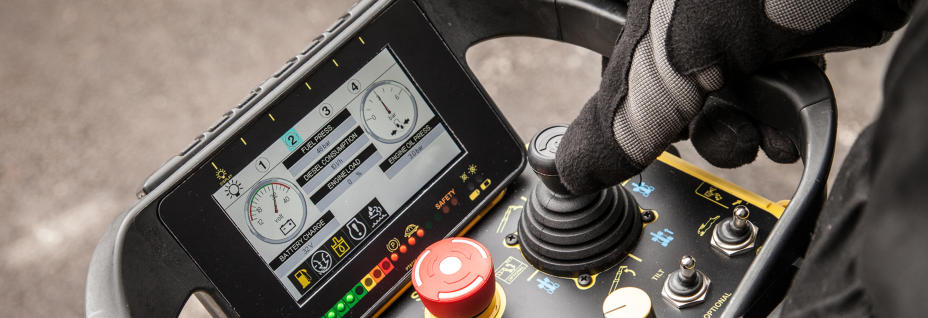
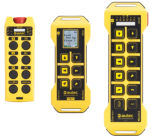



SK4 / SK8B ‘SideKick’ Compact Waist-worn Safety Radio Controls
The SK4 and SK8B controllers can mount up to 4 / 8 actuators respectively, which can be single or double- acting toggle switches, or a single potentiometer. This unit finds wide application on mobile machinery, particularly concrete line pumps, forestry and agricultural machines, and other mobile hydraulics. While most commonly supplied with a DC receiver, AC variants are possible.

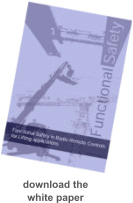

autec safety remote controls
Autec Hand-Held Push-button Safety
Radio Controls
A range of 1-speed and 2-speed controllers from 4-button to 12-button. Some models have the option of additional toggle switches and buttons, and colour displays are available on some models. While many are used on cranes, these controllers also have a huge number of applications in all types of hydraulic and electric machines - both AC and DC.AIR Series - Joystick Safety Radio
Controls - Single-Speed & Multi-Speed
Typically used on all types of crane, other lifting machines, and all types of industrial machinery, these remote controls feature joysticks with single-step or multi-step functions - up to 6 speeds available. There are models to suit all applications including tower- cranes and complex magnet cranes.Dynamic Series - Fully Proportional Safety
Radio Controls
Most commonly used on hydraulic machines, these controllers can
be used on both proportional and on-off systems, and there are
many models and options. Extremely configurable, these systems
can be used for the simplest application, through to complex
tunnelling machines.
Machine-to-Machine Safety Radio Controls
The transmitter in these systems is not carried by an operator, but typically embedded in a machine control panel. This allows for safe real-time communication between machines, or to radio-enable a conventional fixed control-panel.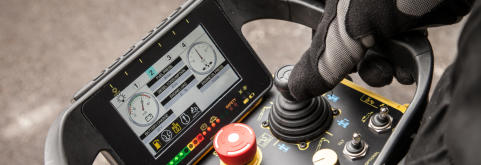
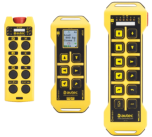


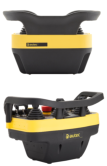
SK4 / SK8B ‘SideKick’ Compact
Waist-worn Safety Radio Controls
The SK4 and SK8B controllers can mount up to 4 / 8 actuators respectively, which can be single or double- acting toggle switches, or a single potentiometer. This unit finds wide application on mobile machinery, particularly concrete line pumps, forestry and agricultural machines, and other mobile hydraulics. While most commonly supplied with a DC receiver, AC variants are possible.
What is a safety remote control?
Safety remote controls are specially designed for the control of potentially hazardous machinery - for example cranes and hoists, concrete pumps, container side- lifters, elevating work platforms, and many others. Safety remote controls are necessary where the failure of the system (e.g. a command turning on unexpectedly, or the STOP failing to operate) could pose a risk of injury or death, or of damage to the machine or other property. Safety remote controls include many special features that increase Functional Safety by increasing the fault-tolerance of the systems. Safety remote controls share little in common with general-purpose remote controls (such as door openers) which do not fail-to-safety. Different applications require different levels of Functional Safety, and various Standards define different categories and performance levels that are sometimes mandated for specific machine types. Safety remote controls must contain specific design features to meet these strict requirements. Amongst these are: - Dual redundant input devices (e.g. joysticks) - Dual redundant output devices (e.g. relays) - Redundant and self-monitoring encoders and decoders - Tamper proof and guaranteed unique addressing systems - Active and passive STOP systems - High-reliability radio links with frequency management These issues are fully discussed in our white paper on Functional Safety in remote control systems, which is recommended reading for anyone considering the application of radio remote controls to machines.Types of safety radio remote control
When selecting a radio remote control for a machine, the best approach is to consider the application firstly from the operator’s perspective: - What form-factor is appropriate? A hand-held controller, or a “belly-box” (a controller worn around the waist)? - What actuators suit the commands that must be given? The available choices, depending on the model of controller, include - single-speed push-buttons - 2-speed push-buttons - Single-speed joysticks (on-off types) - Multi speed joysticks (up to 5 or 6 steps)- typically used on cranes - Fully proportional joysticks- typically used on hydraulic machinery, but also on variable- speed drives - Toggle switches in latching/momentary types - Potentiometers (so-called “pots”) typically used to allow a knob to control the speed of an operation. The design of the machine will also influence the choice of controller, and of the receiver. Considerations include the power supply available, the load being switched, the available space for the installation, and the types of control devices (contactors, valves, solenoids, etc) being operated. If there is a programmable controller on the machine, the receiver and the PLC can communicate over CANOpen with either the receiver, the PLC, or both being responsible for control of the machine elements. Our engineers are widely experienced in many types of machinery, and can help you make the correct decision from the beginning. Please contact us to discuss your application, or for any advice required.Multiple Transmitters, Multiple Receivers
Some applications require that one transmitter control multiple receivers on one machine, or spread over several machines - e.g. if multiple hoists are used to lift a very long load. Other machines require that a single machine is controllable from multiple locations, either as a mutually-agreed hand-over (pitch/catch, typical on cranes), or a unilateral take-control (basket/observer, tyical on elevating work platforms). Another common crane-control scenario enables two cranes that are normally used independently to be operated from a single master/slave remote control in order to do tandem lifts. Autec remote controls manage all of these topologies in a simple, safe, and controlled way - see the page on Multiple Systems for more details.